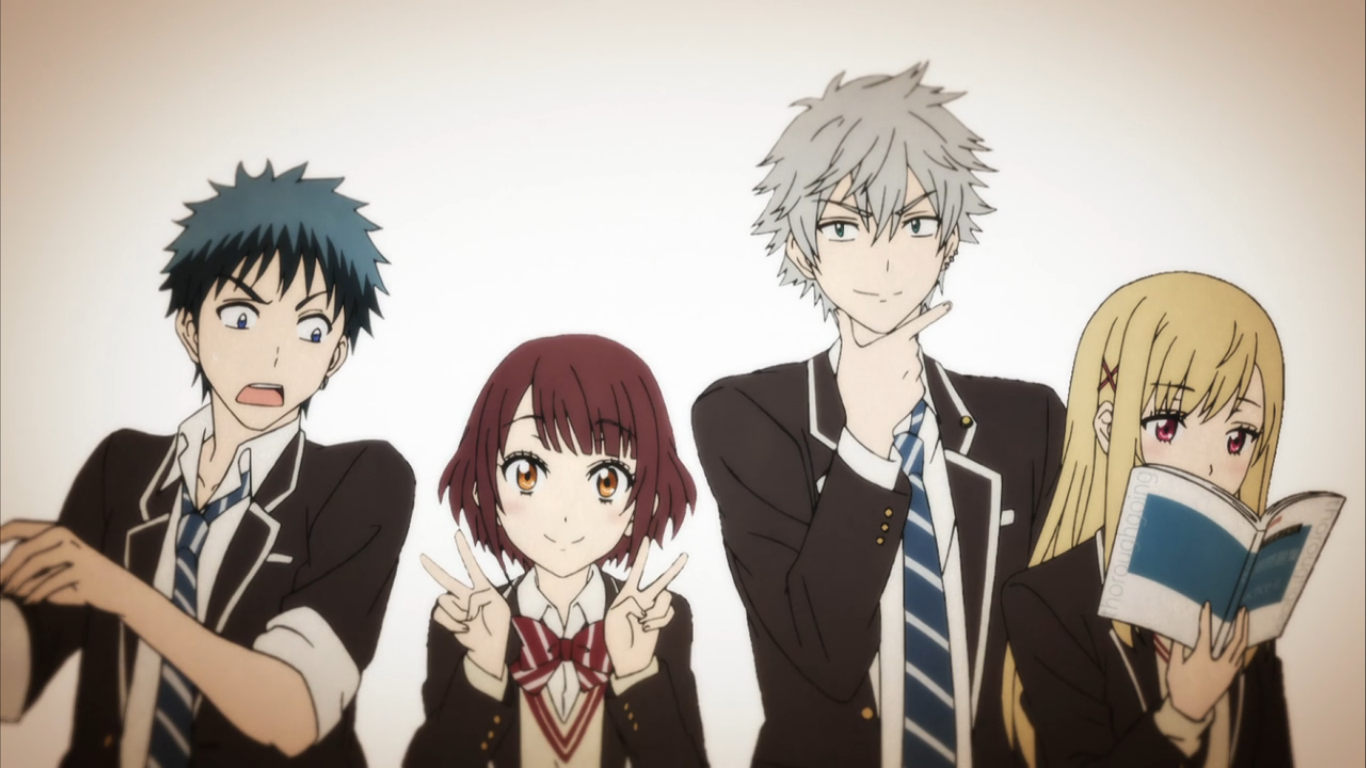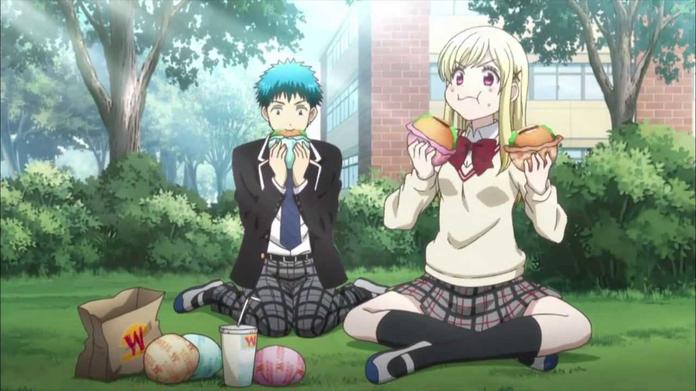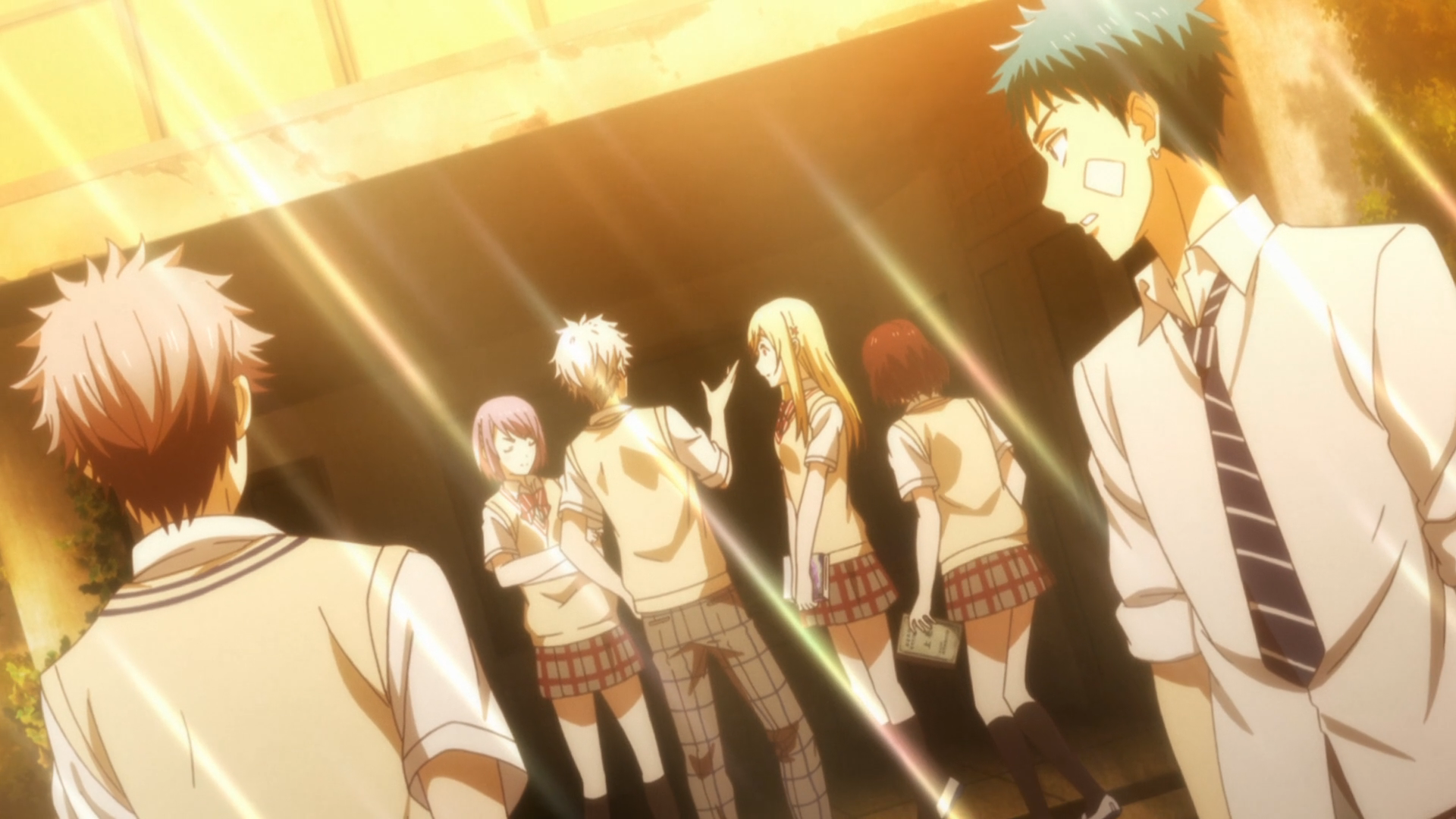It’s rare for me to get excited about a slice of life anime, mostly because it isn’t my favorite genre. While I can appreciate its drama, I need a little more stimulation to get invested in it. Enter Yamada-kun and the Seven Witches which I heard a lot of buzz about (before the anime premiered in Japan). I ended up reading the manga on Crunchyroll and became hooked on the love story between the two main characters Yamada and Shiraishi, as well as the trials and tribulations they both face. While Yamada gets into fist fights here and there, this series held my interest with the romantic drama and tension that you typically get from a slice of life anime. However, did the anime live up to the manga? That is the question that fans of Yamada-kun and the Seven Witches will have to wonder.
https://www.youtube.com/watch?v=olVz3IYD0PE
In this series we follow a delinquent student, Yamada. He gets into fights, does poorly in school, and skips classes and the entire student body is afraid of him. He ends up falling down a flight of stairs and on top of the smartest girl in the whole school, Shiraishi. The two end up switching bodies, and both try to figure out a way to return to normal. After many attempts at recreating the earlier scene, Shiraishi recalls that they also kissed after they fell and tried that to switch back. It worked, and you’d think that’d be the end of it. However, both Yamada and Shiraishi get recruited into the supernatural studies club, which leads to the two switching bodies over and over, as well as getting into trouble with the Student Council and other girls who happen to have mysterious powers of their own. These girls are called witches, and Yamada and his friends in the supernatural studies club decide to figure out the mystery of witches as well as the school.
Being a reader of the manga, I was excited to see how the anime adaptation would hold up. The characters looked just like I remembered from the manga and didn’t give off any weird looks to my eyes. If characters ended up looking odd, then that could have hurt the aesthetics of this series and make the show more of a drag to get through. But I enjoyed the art style a lot more than I thought I would, especially the opening of the series, which was both beautifully animated as well as sounding so sweet. So while the aesthetics looked plain or typical, it indeed wasn’t a deterrent in this series.
The aspect that jumped out at me with Yamada-kun and the Seven Witches is how much the term quid pro quo is in use. Everyone in this series loves to make deals, whether it’s happening between a couple of friends or when someone is asking for a favor from high ranking students. There are always favors to be had, which is something that many high school students can relate to. But it wasn’t something that comes to mind when you think about a slice of life series. It’s almost like we were watching a prosecutor litigate different types of plea deals for defendants. It was during these types of talks or agreements that led to a lot of suspense during Yamada-kun and the Seven Witches. It left me wanting to know who wanted what, what motivated specific individuals, as well as what Yamada and his friends were willing to do to accomplish a task. It’s a different kind of drama that shōnen fans aren’t used to, but offers the same sort of rush that action fans like.
To go along with that, Yamada-kun and the Seven Witches kept fans engaged with how quickly friends became allies, and allies became enemies throughout the show. Much in line with everyone asking each other for favors, friends and alliances were formed at different points. This would lead to some levels of deception for groups to try and get what they want (especially when we saw three groups try to find out who the seventh witch was to become president). But because of that, the antagonist for Yamada could change from episode to episode. So instead of having just one rival who tries to steal the girl of Yamada’s dreams over and over, the main issues Yamada faced was finding out who the witches are and squaring things away so no one would get into huge trouble. An angle that I think was much more fun to watch than a typical romance.

As for the story itself, I found the silly antics at the start cute and fun. It’s an easy way to get into this series. Going through the mishaps of switching bodies and holding onto secrets was fun, especially considering that the guile (or lack thereof) from the kids was endearing. So there were the typical slice of life moments that littered this series, like a beach episode, or a supposed love triangle. But they didn’t slow down Yamada-kun and the Seven Witches when it came down to the primary task of figuring out the witches’ powers, as well as finding out the identity of these people. It wasn’t until Yamada tried to find more witches, as well as the last one, where the series started to become more impactful and you see how the author planned the writing of the Seventh Witch arc.
That particular arc, (which was my favorite in the entire manga), made me applaud the idea of having Yamada not forget everything (by the hands of the seventh witch), but to have everyone else forget about him after he began turning his life around. Just like in the series A World that God Only Knows, it tugged more at the heartstrings. Yamada was a troubled teenager and finally started to make friends and have a reasonable school life, only to have it all ripped away from him due to the Student Council. They went through so much trouble to prevent Yamada from learning the identity of every witch. Not to mention that they even pull a move to get Shiraishi away from Yamada so people can stay in the dark. So watching him do whatever he could to be remembered made the show more emotionally charged. The circumstances that caused both Yamada and Shiraishi to be miserable in school made it easy to cheer them on as they become a couple and remember each other.
There were a few things that weren’t as good as I’d have hoped with the anime (this complaint comes from a manga reader). I was upset with the pace as soon as we met up with Noa Takigawa. Her arc ended very quickly, and it felt like the anime was rushing to get to the Seventh Witch Identity arc (that was going to get animated). I have a feeling that the studio knew they’d only adapt the manga for 12 episodes, so they did what they could to make sure they could animate the final arc fans got to see. It didn’t allow a lot of moments to hit viewers in the heart with all of the tender and sad scenes. It didn’t allow time to appreciate how Yamada and Shiraishi’s relationship grew.
Plus, the final arc was rushed to a point where I felt cheated at points (of course with it being my favorite, I’d be a little more critical of that). I understand that this series was only 12 episodes. But it makes me sad that they couldn’t go for 13 or more to make this arc more impactful. While it hit home on a few scenes, I wanted more impactful moments. Compared to reading the manga, the last arc in the anime was such an emotional roller-coaster, especially waiting week to week. The anime didn’t allow the viewers to feel as bleak as the readers did. Yamada figuring out it wasn’t Shiraishi in her body and trying to find the real Shiraishi were some of the more heart-wrenching moments I’ve ever read. You couldn’t stop reading to see if they’d return to each other. The anime felt hurried, with the embrace being the only scene where you could take everything in. I wanted more moments like that in the anime.
I’d be remiss not to talk about how the humor in Yamada-kun and the Seven Witches touches on a subject that is in the spotlight for national media when it comes to sexual harassment. Seeing Toranosuke Miyamura perform the acts he does with Yamada (no matter what body he is in), could make some viewers cringe. The fact that Yamada approaches girls he’s never met and tries to kiss them can easily be viewed as inappropriate (do not try that in real life). I’m not going to go into great lengths about this because that’s not what this article is about. But It’s something people should be wary of.
Thankfully, I think the anime stopped at just the right point. I also thought that things could have ended in the manga where the anime did. It stinks, knowing how the whole story plays out, and I wish that more of this manga could be adapted into an anime. I found the story a bit repetitive (you can only do so much), but a lot of the mysteries aren’t solved after these 12 episodes, which may leave fans wondering if there’s more to this story. If you are curious what happens after the ceremony, the witches aren’t completely gone. Now that the first group of witches lost their powers, they have been transferred to new students. So the adventures kept on going for a bit longer.

As for the voice cast, I was very interested to hear Newton Pittman and Mikaela Krantz play the roles of Yamada and Shiraishi. Both played the characters as well as I could have expected, with Krantz doing a great job of voicing Shiraishi when Yamada was in her body. In fact, it was my favorite part of her performance. Not to be outdone, Pittman was excellent in both his serious moments and his exuberant behavior. But I give credit to the casting of Yamada-kun and the Seven Witches in that the cast was a mix of familiar and unfamiliar voices. It had voices you’d recognize easily, such as Todd Haberkorn, Alexis Tipton, and Luci Christian, all who did a fantastic job in their roles, especially Haberkorn as Toranosuke Miyamura (he nailed that role). But there was an influx of newer talent that was cool to hear, including Rachel Glass (Miyabi Itou), Jessica Peterson (Nene Odagiri), and Tabitha Ray (Maria Sarushima). I will admit that Peterson sounded a little stiff at points as Odagiri, but it wasn’t something that I noticed a lot.
Minimal extras were included in this release, with only a textless opening and closing offered. I was a little surprised, since this release is part of the FUNimation and Crunchyroll partnership, but it might mean that this property wasn’t as popular as I thought it was. It also comes in a standard Blu-ray/DVD case with a cardboard slipcover.
I finish Yamada-kun and the Seven Witches feeling conflicted. It wasn’t a bad adaptation. In fact, I’d go as far to say it was as good as it could be given the limited amount of episodes. The fact that I know how awesome the manga is, know how the story plays out and understand how everything developed on a slower level, makes me a harsher judge. The anime didn’t do anything to make it stand out as much as the manga. It was just there with a cute gimmick that could draw a casual audience. Seeing Yamada, Shiraishi, and the rest of the main group was beautiful. Those who only watch the anime won’t know the amount of pain and sacrifice Odagiri performs in this story, and it hurts that other characters won’t have their whole story shared. But if I am grading this anime solely on what it did, I’d give it an above average grade for sure. If you enjoyed this anime, I suggest reading the manga. You won’t be disappointed.
Rating: 7.5/10
Pros: Yamada and Shiraishi’s relationship; The message the series convey’s about friendship; Mysteries of the series will keep viewers engaged; Some humor I believe fans will enjoy; Fantastic English dub cast.
Cons: Subject matter of sexual harassment will be tested here; Toward the end, arcs felt rushed; Not a lot of time for relationships/friendships to develop; fans of the manga will wish there were more episodes.
C.J Maffris is an editorial writer for toonamifaithful.com. Feel free to follow C.J on Twitter @SeaJayMaffris


